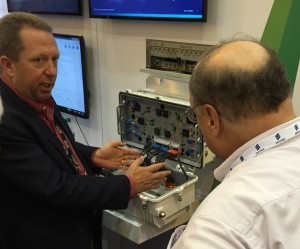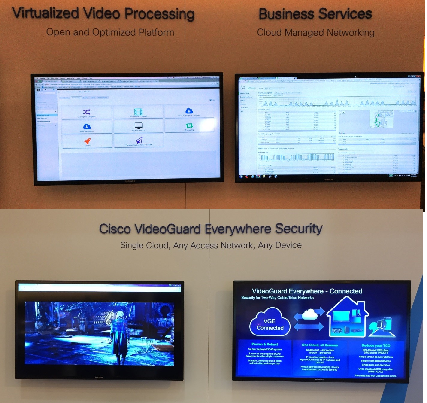Guest Blog by Igor Dayen, SP Product and Solutions Marketing
I am excited to continue the discussion that I started in my previous blog on SCTE Cal-Tec expo.
We brought two cBR-8 routers and we used one to run live data through it. We used Ixia gear to generate video and data traffic. Hence we showed the convergence.

The picture below on the left shows how DOCSIS 3.1 spectrum is being modulated—there are 4096 QAM, while the picture in the middle shows one spectrum for DOCSIS 3.0 and two spectrums for DOCSIS 3.1. Overall, it has been very impressive to see what DOCSIS 3.1 will bring and that we are able to demonstrate DOCSIS 3.1 today. We offered a lot of booth tours and our demo staffers did a lot of presentations to customers who came to the booth. My personal favorite were the hands-on live demonstrations as that was the testament that cBR-8 is operational today with DOCSIS 3.0 traffic and is DOCSIS 3.1 ready.

Next we demonstrated capabilities based on Software Defined Networking (SDN) and Network Function Virtualization (NfV) . These innovations will also allow customers to increase automation and customer self-service, thereby reducing trouble tickets and operating costs. These technologies accelerate new service deployment, as they can be developed as software-based ‘cloud’ applications–disconnected from the underlying hardware–that can be tested, and deployed at scale using MSOs’ internal cloud infrastructures.
First, we showed Cisco SDN Dashboard that allows operators to save OpEx and better manage CapEx. For example we created an SDN app that allows customers monitor cBr-8 remotely. For NfV demonstration, we explained how a virtualized CCAP can perform modem registration and turn-up.

In optical transmission systems, the network platform forms the foundation of the product family. The Prisma II XD platform provides network operators with a full-featured space saving design. Prisma II XD platform is a key component in increased network reliability, scalability, and more cost-effective deployments. In addition to that, GS7000 four-port node is designed to enable broadband video network operators to easily scale services to meet customer demand and generate more bandwidth for more customers as the need for new services increases. What we demonstrated is Cisco’s Distributed Access (Remote PHY) concept that uses GS7000 node. The cBR-8 is designed to support distributed CCAP architecture with Cisco Remote PHY technology. We presented a concept on how RPHY can be implemented.

The Cisco Remote-PHY solution provides a cost-effective digital fiber-based DOCSIS solution that uses Ethernet PON, GPON, or Metro Ethernet as the transmission network between the Cisco CMTS and Cable Modem. Both the PON technology and DOCSIS is used in the same network.

A DWDM solution delivers touchless programmability, massive scale, multi-layer convergence, and ultra-long-haul performance necessary for tomorrow’s network architectures. In the network, cBR-8 connects to NCS 2000 where NCS 2000 backhauls data to the edge and core networks.

In addition to the cable access, the other half of the booth showed Infinite Home Suite which is open and agile, end-to-end software solution, delivering video over cable networks to IP devices within and beyond the home.
There were two solution components emphasized:
- Infinite Video Cloud based As-a-Service solution for the administration, delivery and monetization of video on unmanaged devices
- Cloud DVR & Time Shift TV – extend DVR services to multiple screens, Any content, Any time on Any device

Another important part of the video solution is Cisco Virtualized Video Processing (V2P) which is an open, programmable, scalable and extensible platform. With V2P we explained how to accelerate time to revenue and differentiate by supporting new functionality and use cases. We also demoed how to:
- Enhance agility with workflow driven orchestration and automation
- Reduce TCO with common scalable infrastructure decoupled from video workflow
- Lastly, we had a third component: VideoGuard DRM that is used for OTT + VOD, CatchUp using unicast – protected with DRM using optimized unicast license distribution. VideoGuard CA used for Broadcast/Live (News, Sports) content – protected using multicast license distribution.

Overall, it was a successful exhibition since customers were able to understand our main message and direction.
We emphasized how to work together with customers to transform the experience, transform the architecture, and transform the business.
Tweet us @CiscoSP360 if you have any any questions or comments.

CONNECT WITH US